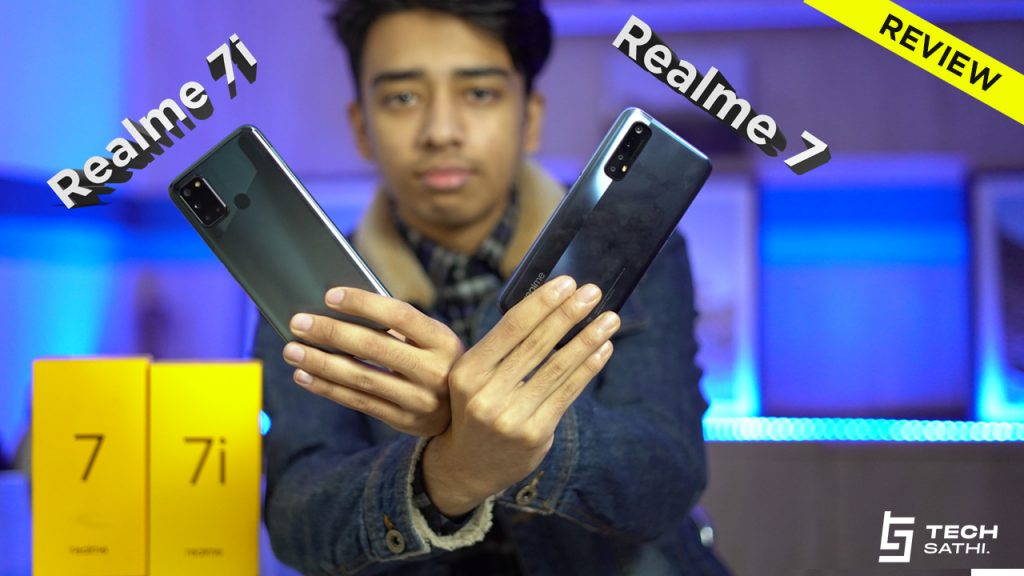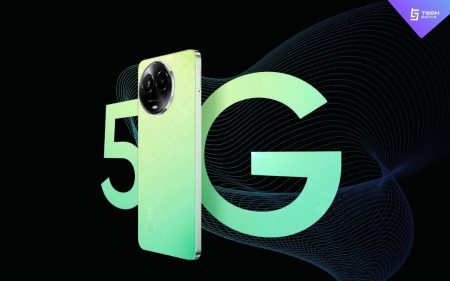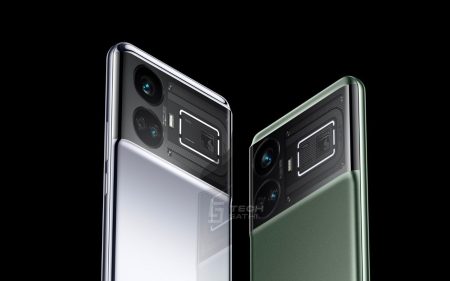After the stock of the Realme 6 series subsided, Realme 7 and Realme 7i was finally launched in Nepal recently. I have been using both phones for more than two weeks now. Both have the same 8GB+128GB variant launched making Realme 7i the only phone in Nepal which provides this configuration under 30k. But how much do they differ and which one should you choose in this Realme 7 vs Realme 7i battle? Are there any cons to these devices? We will be explaining everything in this full review.
Realme 7 vs Realmi 7i Specifications
| Specs | Realme 7 | Realme 7i |
| Dimensions & Weight | 162.3 x 75.4 x 9.4 mm 196.5g | 164.1 x 75.5 x 8.9 mm 188g |
| Build | Corning Gorilla Glass 3 Front Plastic back and frame | Corning Gorilla Glass 3 Front Plastic back and frame |
| Display | 6.5″ FHD+ IPS LCD 2400 x 1080 pixels 20:9 aspect ratio 90Hz refresh rate Punch Hole cutout | 6.5″ HD+ IPS LCD 720 x 1600 pixels 90% screen-to-body ratio 90Hz refresh rate Punch Hole Cutout |
| SoC | MediaTek Helio G95 (12nm) | Qualcomm Snapdragon 662 (11nm) |
| Chipset | Octa-core 2×2.05 GHz Cortex-A76 & 6×2.0 GHz Cortex-A55 Mali-G76 MC4 | Octa-core 4 x 2.0 GHz Kryo 260 Gold & 4 x 1.8 GHz Kryo 260 Silver) CPU Adreno 610 GPU |
| RAM | 8GB LPDDR4x dual-channel | 8GB LPDDR4X dual-channel |
| Storage | 128GB UFS 2.1 | 128GB UFS 2.1 |
| Battery and Charging | 5000mAH 30W Flash Charge USB Type-C port | 5000mAH 18W Fast Charge USB Type-C port |
| Rear Camera | Quad Camera 64MP, f/1.8 with PDAF (main) 8MP f/2.3, FOV 119° (ultra-wide) 2MP f/2.4 (depth) 2MP f/2.4 (macro) LED flash, HDR, Panorama 4K@30fps, 1080p@30/60/120fps, gyro-EIS | Quad Camera 64MP, f/1.8 with PDAF (main) 8MP f/2.3, 119° (ultrawide), 2 MP f/2.4 (depth) 2 MP f/2.4 (macro) LED flash, HDR, panorama 1080p@30fps, gyro-EIS |
| Front Camera | 16MP, f/2.1, 26mm, 1080@30/120fps, gyro-EIS | 16MP f/2.1 26mm, 1080p@30fps, gyro-EIS |
| Operating System | Realme UI, Android 10 | Realme UI, Android 10 |
| Sensors | Magnetic induction sensor Light sensor Proximity sensor Gyro-meter Acceleration sensor Fingerprint scanner (side-mounted) | Magnetic induction sensor Light sensor Proximity sensor Gyro-meter Acceleration sensor Fingerprint scanner (rear-mounted) |
| Other Features | Dual SIM Wi-Fi 802.11 a/b/g/n/ac, dual-band, Wi-Fi Direct Bluetooth 5.0, A2DP, LE FM radio Single Loud Speaker 3.5mm headphone jack | Dual SIM Wi-Fi 802.11 a/b/g/n/ac, dual-band, Wi-Fi Direct, hotspot Bluetooth 5.0, A2DP, LE FM radio Single Loud Speaker 3.5mm headphone jack |
| Colors | Blue, White | Green, Blue, White |
| Realme 7 | Realme 7i | ||
| Pros | Cons | Pros | Cons |
| 90Hz refresh rate | No AMOLED display | 8GB RAM option | Slower and older processor |
| Great gaming chipset | Plastic back and frame | 90Hz refresh rate | 720p display |
| 30W fast charging | 64MP quad-camera setup | Main rear sensor can’t do 4K | |
| Versatile camera |
Realme 7 and Realme 7i Price in Nepal
| Variant | Price in Nepal (MRP) |
| Realme 7 (8GB+128GB) | NPR. 35,990 |
| Realme 7i (8GB+128GB) | NPR. 29,990 |
Also, Read || Realme Phones Price in Nepal
Realme 7 and Realme 7i Full Review
Build and Design
Realme 7 and Realme 7i have identical build and design at first glance so, you can check the spec sheet for detailed differences by numbers. On hand, Realme 7 is slightly heavier and thicker than Realme 7i. The plastic back and framing along with Gorilla Glass 3 protection is the same on both phones. The back design however is different. Realme 7i has an L-shaped lens layout making its module different than the vertical lens layout on the Realme 7.
Realme 7i’s glossy gradient back finish is more of a fingerprint magnet as compared to the frosted finish of the Realme 7. Both have Realme branding on the back but there’s also the presence of a circular rear physical fingerprint scanner on the Realme 7i. The transparent and sturdy plastic case provided in the box for both phones will easily fix that issue of their camera bumps wobbling on a flat surface.
The top side of both phones is empty whereas their bottom consists of a 3.5mm jack, mouthpiece, USB Type-C port, and speaker cutout. On the left side, Realme 7 has a SIM tray along with volume buttons whereas Realme 7i has a SIM tray only. On the right, Realme 7 has a side-mounted physical fingerprint scanner embedded in the power button whereas Realme 7i has the normal power and volume buttons.
Personally, I liked the grip, weight distribution, and back finish of the Realme 7. Also, neither phones have any protection against water, not even some simple coating. So, it’s better to be careful on your own.
Display
Realme 7i’s 6.55-inch HD+ IPS panel vs Realme 7’s 6.5-inch Full HD+ IPS panel. Do I really need to tell which wins here? When you put them side by side, Realme 7i easily loses due to its inferior 720p resolution and lesser brightness. I also found the color reproduction to be better on the Realme 7. 720p resolution at this price range was a really bad move on the Realme 7i. I hope Realme doesn’t repeat that. Both phones have 90Hz refresh rate making navigation and gaming much smoother. I recommend using the auto-select option in the Settings that will adjust the refresh rate as per the things you are using in order to save battery life.
Talking about the display, both phones have a similar placement of a punch-hole cutout on the top left. Just above the top side of the display lies an earpiece but there is no notification LED on either phone.
Performance and Software
Snapdragon 662 on the Realme 7i vs MediaTek Helio G95 on the Realme 7. The same 8GB RAM and 128GB UFS 2.1 storage on both phones makes them equally capable in multitasking and normal UI navigation. The place where the new and improved Helio G95 chipset completely outshines the older and slower Snapdragon 662 is in CPU and GPU intensive tasks. For example, PUBG mobile on Realme 7 can hit up to HD graphics and High Frame Rate settings whereas Realme 7i is limited to Balanced Graphics and Medium Frame Rate even with its lesser 720p resolution. Call of Duty however ran on Very High settings on both phones which were good to see. Nonetheless, the difference between these two chipsets can be noticed more vividly in their benchmark scores. Here you go.
Both phones run on the latest Realme UI v1.0 based on Android 10. So, both have the same UI and with that same 90Hz refresh rate feel equally snappier. I didn’t find any ads on both devices and you can easily uninstall any pre-installed apps which are both good signs for a better user experience. Both phones will also be receiving the Android 11 update in 2021.
Camera
Since the company hasn’t disclosed the sensors used on both phones, I think it will be fair for us to assume that both phones use the same camera setup. If you just look at the megapixels, the assumption seems truer. 64MP main + 8MP ultrawide + 2MP depth + 2MP macro on the rear and a 16MP selfie sensor is present on either phone. Despite having identical sensors, the software processing, and shooting capabilities are different on these.
For daylight pictures, the main 64MP sensor is the only one to have autofocus in either phone. 16MP pixel binned images are equally good from both phones. Realme 7 tends to have a reddish tint which is more prominent in some pictures making them look unnatural. Chroma Boost on the Realme 7 or Dazzle Color on the Realme 7i over-saturates things whereas HDR mode only seemed to improve the dynamic range once in a while. Instead, it just boosted the contrast most of the time. 64MP mode available on both phones include more detail in the images and you can crop them later as there is no telephoto lens on either phone.
The ultrawide pictures have less quality as compared to the main sensor but in ample lighting, they are good enough for the phones of this price range. The post software processing is much aggressive on the Realme 7i as it can be seen increasing the exposure and over-sharpening structures making the photo look unnatural unlike the natural pictures from the Realme 7. Also, a thing to take note of is that both ultra-wide sensors have fixed infinity focus.
The 2MP depth seems to struggle at times in maintaining the edge detection but despite the difference in software processing portraits look good on both phones if the lighting is ample. If you observe closely, you can again see that Realme 7 produces natural images as compared to some extra saturation job on the Realme 7i.
The story continues on the 2MP fixed focus macro shots. They do let you get close to the subject and despite the clarity not being that good on either phone, Realme 7i is obviously more saturated.
In selfies, you can observe the reddish tint easily on the Realme 7. Realme 7i has over sharpened the details but got the color reproduction correct. Both phones result in overexposed background sky, but when we move into selfie portraits, Realme 7i goes all-in with the AI it seems. It does manage to fix the blown-out background but no matter how many times I tried I kept getting that weird line on the sky. I think it is an issue with my unit. To be honest, I like the selfies on the Realme 7i but I didn’t expect this much difference between the two as they have the same sensor.
Realme 7 seems to have less exposure and more reddish tint as compared to the night mode pictures from the Realme 7i. Nonetheless, the main and ultra-wide sensor of both phones struggles to keep up during night time. Turning on night mode drastically improves the exposure, details, and dynamic range if you are okay with a slight increase in noise.
In terms of video capabilities, Realme 7i can shoot up to 1080p@30fps from the rear sensor whereas Realme 7 can go up to 4k@30fps. I didn’t find the Ultra Steady Video option making that much of an improvement in the stabilization. I recommend you avoid it as it zooms in too much and ruins the quality of the videos. The EIS and software stabilization on normal videos is good enough and it’s better to buy a gimbal if you want more stability. Now I hate to say this but Realme 7i has some extra useful camera settings in the default camera app like Text Scanner and Pro Video Mode which the big brother Realme 7 lacks.
Selfie videos are soft and natural on the Realme 7i whereas Realme 7 still has that reddish tint but captures more details. Both phones shoot selfie videos up to 1080p@30fps but Realme 7 can also shoot slo-mo selfies i.e., 1080p at 120fps. Since we are into slow motion territory, from the rear sensor Realme 7i can shoot 1080@120fps whereas Realme 7 can go up to 720p@240fps as well. The slo-mo videos are of decent quality for this pricing but only if the lighting is good.
In the conclusion of Realme 7 vs Realme 7i, sometimes I liked the pictures from the Realme 7 whereas sometimes it was clear that Realme 7i did better. I don’t know if it’s just a problem with my unit but that reddish tint from the Realme 7 was quite noticeable at times. So, which phone resulted in better pictures? Were you able to decide? Let us know in the comments down below.
Security and Other Features
The physical fingerprint scanner on both phones is equally fast but the one on Realme 7 is more prone to accidental touches when taking the phone in or out of the pocket. After a few accidental touches, it can only be unlocked by a PIN which is a bit irritating at times. Face Unlock also works equally well on both phones but it isn’t much secure.
There is no other significant feature difference between these phones. Both have the latest Wi-Fi 6 and Bluetooth 5.0. Both phones also support Dual-4G SIM along with a micro-SD card up to 256GB. Realme 7 does have NFC which Realme 7i doesn’t but I doubt Nepalese people will see that as a major difference in their day-to-day usage. In Realme 7 vs Realme 7i, Realme 7 has Wide Vine L1 support which the Realme 7i lacks due to its lesser resolution.
The single downward-firing speaker has a very similar sound quality and loudness. I mean they are both good for a lower mid-range phone. Here, why don’t you decide which one’s better!
Battery
Talking about Realme 7 vs Realme 7i, both have a 5000mAh battery which lasted me for more than a day of normal usage. In our continuous mixed usage test with 50% brightness, Wi-Fi on and at 90Hz, Realme 7 lasted around 8 hours and 20 min whereas Realme 7i lasted 40 minutes more. These are pretty impressive numbers so; I have no complaints regarding battery life.
Now, during our intensive gaming test, the maximum temperature was not more than 42-degree Celsius on both phones. So, no heating issues on either. Realme 7i does lag a bit after long hours of gaming due to its inferior chipset.
For charging, the 30W Dart charger of the Realme 7 takes only 80 minutes to fully juice it up whereas the 18W charger on the Realme 7i was quite slow comparatively. It took nearly 2 hours and 30 minutes to fully charge the phone from 0 to 100.
Conclusion
Taking the Nepalese price into consideration, the 720p resolution of the Realme 7i is indeed a bummer but if you can get over it for that snappy 90Hz it provides, you can consider this phone. The Snapdragon 662 may seem like another downside but if you are not a gamer, it is more than enough for all other kinds of tasks. With similar camera performance as Realme 7, 8GB RAM, and 128GB storage at this price is indeed a steal.
Realme 7, on the other hand, is a great phone but again the Nepalese pricing is questionable. If you want that 90Hz and faster processor, I don’t see any other official competitor in the Nepalese market right now.






14 Comments
Great comparison! It’s interesting to see how both phones stack up against each other in terms of features and performance. I’m particularly leaning towards the Realme 7 for its camera capabilities. Thanks for the detailed insights!
Great comparison! It’s interesting to see how the Realme 7 and 7i stack up against each other. Your insights on performance and camera quality really helped me decide which one might be the better option for my needs. Thanks for the detailed analysis!
Great comparison! I appreciate the detailed breakdown of both models. It really helped me understand the differences and make a more informed decision. The camera performance highlights were particularly useful for someone like me who loves photography on the go. Thanks for the insights!
Great comparison! I appreciate the detailed analysis of both devices. It’s interesting to see how the Realme 7 holds up against the 7i in terms of performance and camera quality. Your insights will definitely help in making an informed choice. Looking forward to more reviews like this!
Great comparison! I appreciate the detailed breakdown of the specs and camera capabilities. It really helps in making an informed decision between the Realme 7 and 7i. Can’t wait to see how these perform in real-life usage!
Great comparison! I appreciate the detailed insights on the performance and camera capabilities of both the Realme 7 and 7i. It’s helpful to see how they stack up against each other, especially for budget-conscious buyers like me. Thanks for the thorough breakdown!
Great comparison! It’s interesting to see how both the Realme 7 and 7i stack up against each other. I appreciate the detailed analysis on performance and camera capabilities. It really helps in making an informed decision!
Great comparison in the review! I appreciate the detailed breakdown of the specifications and camera performance. It really helped me understand the key differences between the Realme 7 and Realme 7i. Looking forward to more tech comparisons like this!
Great comparison! It’s fascinating to see how both models stack up against each other. I’m particularly interested in the camera performance and battery life differences. Your insights really help in making an informed decision!
Great comparison! The detailed breakdown of the specs really helps in understanding the differences between the Realme 7 and 7i. I was leaning towards the Realme 7 for its camera capabilities, but the battery life on the 7i looks tempting too. Looking forward to more reviews like this!
Great comparison! I found the detailed analysis of the camera performance really helpful. It’s clear that both phones have their strengths, but I’m leaning towards the Realme 7 for its superior features. Thanks for the insights!
Great comparison! I appreciate the detailed breakdown of specs and camera performance between the Realme 7 and 7i. It really helps in understanding which model suits my needs better. Looking forward to your future reviews!
Great in-depth comparison! I appreciate the detailed analysis of the features and performance differences between the Realme 7 and 7i. It really helps in making an informed decision. Excited to see how these models stack up in real-world usage!
Great comparison! It’s interesting to see how the Realme 7 and 7i stack up against each other. The camera features really caught my attention. Thanks for the detailed insights!